St. Julian the Poor Melkite Greek Catholic Parish

Celebrations:
Sundays and feast days at 11 a.m
Weekdays at 12:15 p.m
It is open to the public every day between 9:30 a.m. and 1 p.m., and between 3 p.m. and 6:30 p.m.
At the end of 1888, Father Kateb rents the church of Saint-Julien-le-Pauvre, the former chapel of the Hôtel-Dieu, closed since the transfer of the latter to the Île de la Cité. Located at the end of a courtyard, in a sordid district, the church was in a lamentable state. After its restoration, it could be solemnly dedicated to the liturgical celebrations of the Melkite Greek Catholic Church, on Sunday May 5, 1889. T
Three years later, in 1892, the famous master from Damascus, Girgi Bitar, who died in the odor of sanctity, made the iconostasis in mosaic marquetry that can still be seen in the church, and came to Paris to install it by himself. This iconostasis originally included three horizontal rows of icons; but, at the request of the Historic Monuments State Service, the upper row was removed in 1960 in order to make the upper parts of the apse more visible.
The Saint-Julien-le-Pauvre church is one of the oldest churches in old Paris. As early as the 6th century, Grégoire de Tours mentions a basilica of Saint Julien-Martyr. Devastated in the 9th century by the Normans, it was replaced by a temporary chapel, until, in 1165, it was replaced by a new church built in the Gothic style, at the same time as Notre-Dame de Paris cathedral: this is the one we still see today. A victim over the centuries of vicissitudes that lead it to the brink of ruin, it became the "Chapelle de l'Hôtel-Dieu" in 1660. But when it was destroyed, it was closed. Then, classified as a historical monument, it was assigned in 1889 to the Greek-Melkite Catholic cult.
